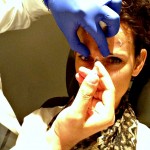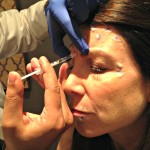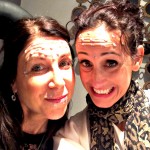The Brazen Scoop: 12 Facts You Didn’t Know About Botox

Of all the cosmetic enhancements out there, it’s the one everyone knows about: Botox. Touted the ultimate miracle wrinkle eraser and the official face freezer, this drug is seriously popular. But what do you really know about BOTOX Cosmetic®? Are we smart to get on board or are we nuts?
We’ve already written about this ubiquitous (it’s literally the most common cosmetic treatment in the world) quick fix for the signs of aging that trouble us most—frown lines, forehead wrinkles, lipstick furrows. And in the name of beauty, we’ve given you exercises to keep wrinkles at bay, the lowdown on how injectable procedures work, and published a couple of fascinating opposing views on cosmetic surgery.
Would you try it? We did.
We set out to give the most popular cosmetic treatment a test drive (and be your resident Botox guinea pigs). So we let our faces do the walking and talking. Yep, just for you, we got shot again and again with Botox, aka botulinum toxin, a substance produced by a bacteria called Clostridium botulinum.
Here’s the Scoop on Botox:
- The procedure is about getting needles stuck in your face so yes, it hurts a bit. If you’re against pain, the doctor can dab on some freezing cream, which makes it pretty much go away.
- The doctor may mark the spots he’s going to treat in advance so you can see how many shots you’re getting.
- There may be some redness or tiny red pinpricks after, which disappear pretty fast.
- You should hold the spots tightly with a tissue after the treatment to help combat the possibility of slight bruising.
- You may feel a bit of pain where you were treated, but it dissipates quickly.
- The effects of the treatment come on gradually so you may not see or feel the full effect—erased wrinkles, reduced mobility—for a few days.
- Be prepared for reduced mobility in the treated areas. You may not be able to lift your brows, for instance, so that might take some adjustment on your part.
- Remember that the lack of movement is precisely what helps reduce wrinkles, so it’s all for the best.

We learned that botulinum toxin is a neuromodulator that paralyzes muscles. When used appropriately in small doses, it can produce excellent medical (treatment of migraines, muscle spasms, sweating, etc) and cosmetic results. BOTOX, Cosmetic® Dysport, and Xeomin are the three neruomodulators that are available in Canada.
Why use Botox?
- To reduce wrinkles—frown lines, forehead wrinkles, crow’s feet—that happen when the face animates
- To soften a perpetually angry, tired, or sad look by providing a more youthful expression to the face
- To prevent early onset of deep wrinkles, particularly for those with habitual facial movements such as brow furrowing
- To tame overly powerful facial muscles or to provide more shape and elegance to the facial contour

12 FACTS YOU DIDN’T KNOW ABOUT BOTOX
1. HOW MUCH SHOULD I TREAT?
Less is more. When it comes to cosmetic injectables, take a conservative approach. You can always add more, but honey, you can’t take it out. Unless you want to look like a mannequin, that is. The practitioner should first consult with you, and after a full facial analysis, provide a tailored approach that fits with your visual end-game.
2. HOW DO I CHOOSE THE AREA?
What’s bugging you? Share your woes with the doc and then work together on a plan. Botox can treat forehead lines, frown lines, crow’s feet, eyebrow areas, lip lines, dimpled chin, and neck bands. It can also be used to provide a non-surgical eyebrow lift, or counteract a down-turned or gummy smile.
3. HOW DO I PREPARE?
While Botox is common and relatively harmless, you should prepare for treatment to minimize the risk of bruising and swelling. Avoid taking blood thinners or herbal remedies that can cause bleeding in the week leading up to your treatment, both for Botox and for facial filler injections. Examples of these medications include aspirin, ibuprofen, vitamin E, Ginko Bilboa, ginseng, St. John’s Wart and fish oils.
4. WHAT SHOULD I EXPECT?
This treatment is a no-brainer. You’ll need an hour or so, depending on what you’re having done. Botox injections are performed using the tiniest needles available. For most people, it feels like an annoying series of mosquito bites. If you’re sensitive, or are having many injections, you can ask the doctor to use a numbing cream.
5. IS THERE AFTER CARE?
You may see a little redness at the injection sites, which should settle within the hour. Feel free to continue about your day, but stay upright for three hours (don’t inject before nap time). Consult with your doctor about avoiding the above listed blood-thinning medications for 24 hours as well as staying away from strenuous activity, other facial treatments (massage, peels, etc.) and too much alcohol.
6. HOW LONG UNTIL IT WORKS?
Botox begins to take effect at 2-3 days, and achieves full effect at one week. First-time patients should see their doctor again at the 2-week mark to assess the result and perform any touch-ups as needed.
7. HOW LONG DOES IT LAST?
Typically, the effects last 3-4 months. After this time, muscle movement returns to normal, and repeat injections are required.
8. WHAT ARE THE RISKS?
Just like with any procedure, there are general risks so it’s best to be treated by an experienced practitioner. For Botox injections, some rare and short-lived possibilities include swelling, bruising, bleeding, or allergic reactions. Specific to Botox and the area of injection, other risks include asymmetry, undesirable result (too much or too little effect), eyebrow droop, eyelid droop (requiring eye drops), and speech or swallowing difficulties.
9. WHO SHOULD NOT GET BOTOX?
Stay away if you’re pregnant or breastfeeding, have exhibited a previous allergic reaction to Botox, have an active infection in the areas to be injected, or have a degenerative neuromuscular condition (eg. ALS).
10. WHO SHOULD INJECT BOTOX?
There are many excellent and qualified injectors. Look for someone you connect well with on a personal basis, who is well trained, qualified and is focused on treatments of the face. The advantage of going to a Facial Plastic Surgeon is that they have a detailed and intimate knowledge of the anatomy of the face, and the interplay between delicate structures.
11. HOW MUCH DOES IT COST?
Costs can vary depending on practitioner, and on the number of areas you wish to treat, but expect to spend $300-$600 per visit.
12. WHICH TREATMENTS WORK WITH BOTOX?
If you’re looking for more than just a light refresh, ask your practitioner about other procedures as well in order to get a global approach to facial analysis. Recommendations for your overall appearance may include medical grade skincare, skin resurfacing peels, facial injectable fillers, or surgical treatment options. Your ultimate goal should be a rejuvenated look—you know, that everyone will notice, but won’t figure out.










